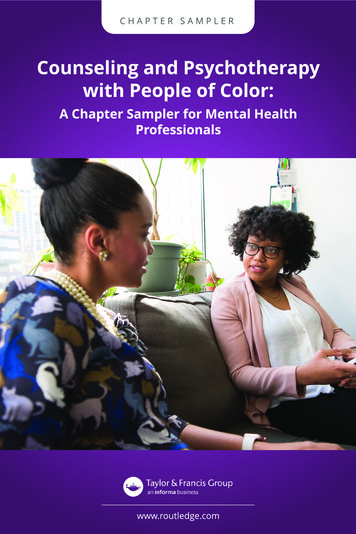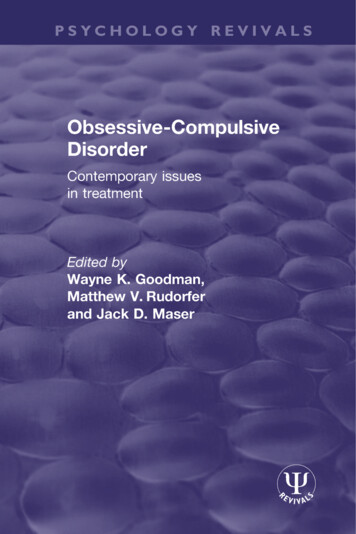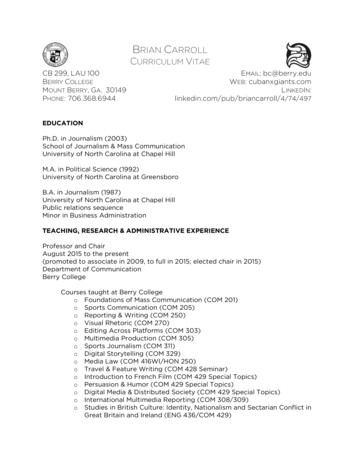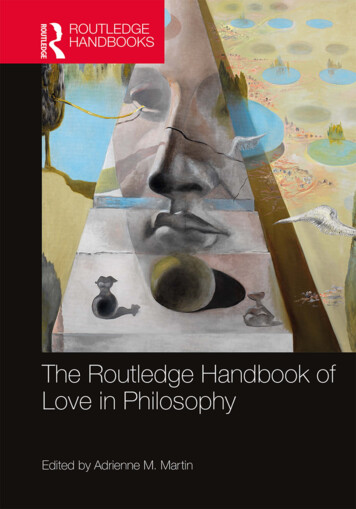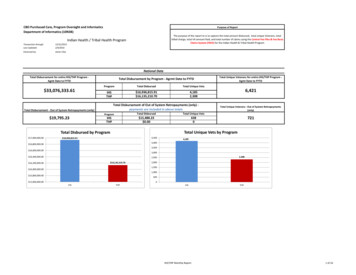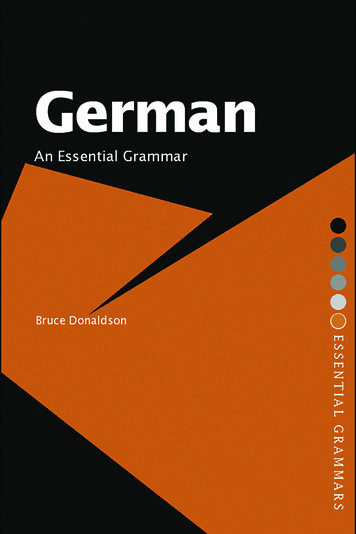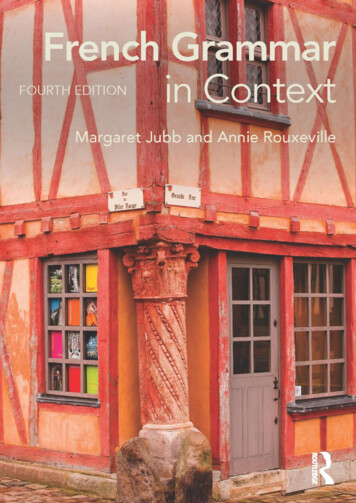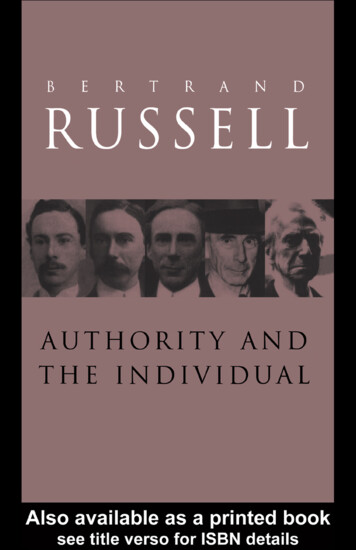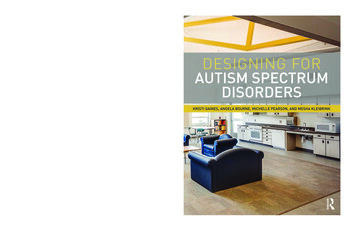
Transcription
“Designing for Autism Spectrum Disorders displays inventive environmental designs for people with disabilities, using aunique and sensitive understanding of their strengths and challenges to see these spaces from a different perspective.This attention to detail envisions beautiful spaces that allow those with autism to thrive. My organization will utilize thissensitivity as we grow our community for adults with intellectual disabilities, planning the living and working spaces we willbuild in the years to come.”– Carol Whitmore, Director, Admissions and Education Programs, The Brookwood Community, Texas, USADesigning for Autism Spectrum Disorders explains the influence of the natural and man-made environment on individualswith autism spectrum disorders (ASD) and other forms of intellectual/developmental disabilities (IDD). Drawing on the latestresearch in the fields of environmental psychology and education, the authors show how architecture and interior spacescan positively influence individuals with neurodiversities by modifying factors such as color, lighting, space organization,textures, acoustics, and ventilation. Now you can design homes, therapeutic environments, work environments, and outdoorspaces to encourage growth and learning for the projected 500,000 children with ASD (in the United States alone) who areexpected to reach adulthood by 2024.Topics discussed include: Environmental design theoriesSymptoms of ASDSensory processing deficitsDesign needs of individuals on the spectrum at all agesDesign methods and solutions for spaces, including residential, learning, work, and therapeutic environmentsencompassing a wide range of budgetsDesigning for self-actualization, well-being, and a high quality of life for the duration of an individual's lifeAvenues for healthy living and aging in placeBiophilic designEnvironmental impact on well-beingStrategies to promote active living as an integral part of the welfare focus.Angela Bourne is an Interior Designer and Educator at Fanshawe College in Canada. Over her 30 plus years in theprofession, she has kept current by regularly practicing interior design and most recently combined her PhD research inEnvironmental Design with her practice to form her holistic company, "Neuro-Considerate Design."Michelle Pearson is an Assistant Professor in the Interior Design Program at Texas Tech University. She received her PhDin Interior and Environmental Design. Her research focuses on built environments that promote health and wellness inchildren.Mesha Kleibrink graduated from Texas Tech University with a Bachelor of Interior Design and Master of Science inEnvironmental Design. She is an associate member of IIDA and currently works as an interior designer and analyst at theTexas Tech University Health Sciences Center.Interior Design / Environmental Design / AutismCover image: Designed by Design Plus LLC, Albuquerque, NM Photographed by Kirk Gittings PhotographyISBN 978-0-415-72527-99 780415 725279www.routledge.comRoutledge titles are available as eBook editions in a range of digital formatsKristi Gaines, Angela Bourne,Michelle Pearson, and Mesha KleibrinkKristi Gaines is the Director of the Graduate Programs in Interior and Environmental Design at Texas Tech University. Shereceived her Ph.D. in Environmental Design with collaterals in architecture and special education. Dr. Gaines has a combined20 years of professional interior design and teaching experience.Designing for Autism Spectrum Disorders“Designing for Autism Spectrum Disorders is a much-needed resource for administrators, teachers, care givers, anddesigners. It will be an invaluable asset that ultimately will improve the built environment for countless children and adults.”– Rupal Engineer, Principal, Design Plus LLC, Albuquerque, USADesigning forAutism SpectrumDisordersKristi Gaines, Angela Bourne, Michelle Pearson, and Mesha Kleibrink
Designing forAutism SpectrumDisordersKristi Gaines is the Director of the Graduate Programs in Interiorand Environmental Design at Texas Tech University. She receivedher PhD in Environmental Design with collaterals in Architectureand Special Education. Dr. Gaines has a combined 20 years ofprofessional interior design and teaching experience.Designing for Autism Spectrum Disorders explains the influenceof the natural and man-made environment on individuals withautism spectrum disorders (ASD) and other forms of intellectual/developmental disabilities (IDD). Drawing on the latest researchin the fields of environmental psychology and education, theauthors show how architecture and interior spaces can positivelyinfluence individuals with neurodiversities by modifying factorssuch as color, lighting, space organization, textures, acoustics, andventilation. Now you can design homes, therapeutic environments,work environments, and outdoor spaces to encourage growth andlearning for the projected 500,000 children with ASD (in the UnitedStates alone) who are expected to reach adulthood by 2024.Topics discussed include: Angela Bourne is an Interior Designer and Educator at FanshaweCollege in Canada. Over her 30 plus years in the profession, shehas kept current by regularly practicing interior design and mostrecently combined her PhD research in Environmental Designwith her practice to form her holistic company, ”Nero-ConsiderateEnvironments.”Michelle Pearson is an Assistant Professor in the Interior DesignProgram at Texas Tech University. She received her PhD inInterior and Environmental Design. Her research focuses on builtenvironments that promote health and wellness in children.Environmental design theoriesSymptoms of ASDSensory processing deficitsDesign needs of individuals on the spectrum at all agesDesign methods and solutions for spaces, including residential,learning, work, and therapeutic environments encompassing awide range of budgetsDesigning for self-actualization, well-being, and a high qualityof life for the duration of an individual's lifeAvenues for healthy living and aging in placeBiophilic designEnvironmental impact on well-beingStrategies to promote active living as an integral part of thewelfare focus.Mesha Kleibrink graduated from Texas Tech University with aBachelor of Interior Design and Master of Science in EnvironmentalDesign. She is an associate member of IIDA and currently worksas an interior designer and analyst at the Texas Tech UniversityHealth Sciences Center.i
“Designing for Autism Spectrum Disorders is a much-needed resourcefor administrators, teachers, care givers, and designers. It will be aninvaluable asset that ultimately will improve the built environment forcountless children and adults.”Rupal EngineerPrincipal, Design Plus LLC, Albuquerque, USA“Designing for Autism Spectrum Disorders displays inventiveenvironmental designs for people with disabilities, using a unique andsensitive understanding of their strengths and challenges to see thesespaces from a different perspective. This attention to detail envisionsbeautiful spaces that allow those with autism to thrive. My organizationwill utilize this sensitivity as we grow our community for adults withintellectual disabilities, planning the living and working spaces we willbuild in the years to come.”Carol WhitmoreDirector, Admissions and Education Programs,The Brookwood Community, Texas, USA
Designing forAutism SpectrumDisordersKristi Gaines, Angela Bourne,Michelle Pearson, and Mesha Kleibrink
First published 2016by Routledge711 Third Avenue, New York, NY 10017and by Routledge2 Park Square, Milton Park, Abingdon, Oxon OX14 4RNRoutledge is an imprint of the Taylor & Francis Group,an informa business 2016 Taylor & FrancisThe right of Kristi Gaines, Angela Bourne, Michelle Pearson andMesha Kleibrink to be identified as authors of this work has beenasserted by them in accordance with sections 77 and 78 of theCopyright, Designs and Patents Act 1988.All rights reserved. No part of this book may be reprintedor reproduced or utilised in any form or by any electronic,mechanical, or other means, now known or hereafter invented,including photocopying and recording, or in any informationstorage or retrieval system, without permission in writing from thepublishers.Trademark notice: Product or corporate names may betrademarks or registered trademarks, and are used only foridentification and explanation without intent to infringe.Library of Congress Cataloguing in Publication DataNames: Gaines, Kristi, author.Title: Designing for autism spectrum disorders / Kristi Gaines,Angela Bourne, Michelle Pearson and Mesha Kleibrink.Description: New York : Routledge, 2016. Includesbibliographical references and index.Identifiers: LCCN 2015046509 ISBN 9780415725279 (hardback :alk. paper) ISBN 9781315856872 (ebook)Subjects: LCSH: Senses and sensation in architecture. Architecture—Psychological aspects. Design—Humanfactors. Autism spectrum disorders.Classification: LCC NA2543.S47 G35 2016 DDC 720/.47—dc23LC record available at http://lccn.loc.gov/2015046509ISBN: 978-0-415-72527-9 (hbk)ISBN: 978-1-315-85687-2 (ebk)Acquisition Editor: Wendy FullerEditorial Assistant: Grace HarrisonProduction Editor: Hannah ChampneyDesigned and typeset by Alex Lazarou
ContentsIllustration creditsviiAcknowledgementsxContributorsxiPart 11beginnings1 Introduction to Autism SpectrumDisorders (ASD)Part 2Part 332 Foundational Theories for ASD113 Human–Environment Interaction194 Perception, Cognition, and Sensation41designing for the senses515 Sight536 Auditory717 Touch/Tactile818 Proprioceptive and Vestibular Senses87designing realistic environments959 Design Considerations for ASD9710 Learning Environments11511 Home Environments13312 Work Environments15313 Therapeutic Environments16514 Connections to the Outdoors179Glossary199References205Index215v
DedicationsKristi GainesMichelle PearsonTo Taylor, for his positive attitude and “can-do” approach to life thatmakes the world a better place.To Derik for being my biggest supporter and best friend.To Bruce, Constance, Brandon, Matthew, Brian, Natalie, Connor, andCarson for their love, support, and encouragement.To my family, new and old, for all the love and encouragement.To Capri and Madison for being there through it all. I couldn’t have donethis without you.To my mother, Jo Scott. Throughout her life she modeled a hardwork ethic and a desire for excellence. She believed that I could doanything. This book is part of her legacy.Mesha KleibrinkAngela BourneTo my brother Ted, and all his friends, who made me aware of theneeds of people with intellectual and developmental disabilities.To Greg, my husband, who was always there for me while I spentmany hours working on this book and my dissertation.To Donnie and Vanessa, our children, who also were behind me all theway during the book writing process.To many supportive friends and family members who accepted me backinto their lives after I missed many events to fulfill this challenge.I love you all. Angie and MomTo Jack, thank you for the impact you made so many years ago. Thisbook is for you.To Kyler, thank you for your overwhelming amount of support and love.I couldn’t do it without you.To Mom and Dad, thank you for teaching me to believe in myself. Yourlove and sacrifice have made everything in my life possible.I love you all.
Illustration creditsfront cover photoDesigned by Design Plus LLC, Albuquerque, NM. Photographed byKirk Gitttings Photographychapter 1Table 1.1Compiled by Kathryn Lopezchapter 22.1Illustration by Michelle Pearsonchapter pyright: ElenartsAdapted from Hall’s Theories of Proxemics, (Hall, 1969,113–125); Illustrated by Nizar HaddadAdapted from Hall’s Theories of Proxemics, (Hall, 1969,113–125); Illustrated by Nizar HaddadCopyright: Mr Interior; Image ID 286124783Illustrated by Elizabeth Johnston-Howard, Copyright:Angela BourneThe Brookwood Community, Brookshire, TexasIllustrated by Elizabeth Johnston-Howard, Copyright:Angela BourneCopyright: Angela BourneCopyright: Angela BourneCopyright: Angela BourneCopyright: BreadmakerCopyright: Angela BourneCopyright: Angela BourneCopyright: Angela Bournechapter 44.2Part of the Teaching students with autism: A resource guidefor schools Victoria: British Columbia Ministry of Education,Special Programs Branch, British Columbia, 2003chapter 5Table 5.1Table 5.2Table 5.35.15.25.35.45.55.6Part of the Teaching students with autism: A resource guidefor schools Victoria: British Columbia Ministry of Education,Special Programs Branch, British Columbia, 2003Adapted from Interiors: An Introduction by K. J. Nielsonand D. A. Taylor, 2007, pp 59–74Adapted from Interiors: An Introduction by K. J. Nielsonand D. A. Taylor, 2007, pp 59–74Copyright: AekikuisCopyright: Sompoch TangthaiDesigned by Design Plus LLC, Albuquerque, NMDesigned by Design Plus LLC, Albuquerque, NMCopyright: Design Plus LLC, Albuquerque, NMDesigned by Baskervill, Architects & Engineers;Photography by Lee Brauervii
i l l u s t r at i o n c r e d i t s5.75.85.95.10Designed by Baskervill, Architects & Engineers;Photography by Lee BrauerDesigned by Baskervill Architects & Engineers;Photography by Lee BrauerDesigned by Baskervill Architects & Engineers;Photography by Lee BrauerDesigned by Baskervill, Architects & Engineers;Photography by Lee Brauer7.67.7chapter 8Table 8.18.18.28.38.48.5chapter 6Table 6.1Table 6.26.16.26.36.46.56.6Part of the Teaching students with autism: A resource guidefor schools Victoria: British Columbia Ministry of Education,Special Programs Branch, British Columbia, 2003Adapted from Statistics for the Decibel (Loudness)Comparison Chart taken from a study by Marshall Chasin,M.Sc., Aud(C), FAAA, Center for Human Performance &Health, Ontario, CanadaDesigned by Design Plus LLC, Albuquerque, NMAdapted from Seep, B., Glosemeyer, R., Hulce, E., Linn,M., & Aytar, P. (2000), Classroom Acoustics: A Resource forCreating Environments with Desirable Listening ConditionsAdapted from Seep, B., Glosemeyer, R., Hulce, E., Linn,M., & Aytar, P. (2000), Classroom Acoustics: A Resource forCreating Environments with Desirable Listening ConditionsAdapted from Seep, B., Glosemeyer, R., Hulce, E., Linn,M., & Aytar, P. (2000), Classroom Acoustics: A Resourcefor Creating Environments with Desirable ListeningConditionsAdapted from Seep, B., Glosemeyer, R., Hulce, E., Linn,M., & Aytar, P. (2000), Classroom Acoustics: A Resource forCreating Environments with Desirable Listening ConditionsAdapted from Seep, B., Glosemeyer, R., Hulce, E., Linn,M., & Aytar, P. (2000), Classroom Acoustics: A Resource forCreating Environments with Desirable Listening Conditions From Part of the Teaching students with autism: A resourceguide for schools Victoria: British Columbia Ministry ofEducation, Special Programs Branch, British Columbia,2000Copyright: Iriana ShiyanCopyright: ChameleonsEyeCopyright: Shvaygert EkaterinaCopyright: Iriana ShiyanImage courtesy of The Brookwood Community, Brookshire,Texaschapter 9chapter 7Table 7.1Copyright: Mariusz S Jurgielewicz; Image ID 128799082from ShutterstockCopyright: ZouZou; Image ID 247008373 from ShutterstockFrom Part of the Teaching students with autism: A resourceguide for schools Victoria: British Columbia Ministry ofEducation, Special Programs Branch, British Columbia,2000Photo courtesy of The Brookwood Community, Brookshire,TexasCopyright: In Green; Image ID 196276397 fromShutterstockImage ID 198150539; Copyright: OSORIOartistCopyright: WorldWide; Image ID 275107637 fromShutterstockImage ID 97794683; Copyright: Ronstik from Shutterstock9.109.11Illustrated by Elizabeth Johnston-Howard, Copyright:Angela BourneIllustrated by Elizabeth Johnston-Howard, Copyright:Angela BourneIllustrated by Elizabeth Johnston-Howard, Copyright:Angela BourneIllustrated by Elizabeth Johnston-Howard, Copyright:Angela BourneIllustrated by Elizabeth Johnston-Howard, Copyright:Angela BourneIllustrated by Elizabeth Johnston-Howard, Copyright:Angela BourneIllustrated by Elizabeth Johnston-Howard, Copyright:Angela BourneIllustrated by Elizabeth Johnston-Howard, Copyright:Angela BourneIllustrated by Elizabeth Johnston-Howard, Copyright:Angela BourneIllustrated by Elizabeth Johnston-Howard, Copyright:Angela BourneIllustrated by Elizabeth Johnston-Howard, Copyright:Angela BourneIllustrated by Elizabeth Johnston-Howard, Copyright:Angela Bournec h a p t e r 1010.1viiiCopyright: Locke Science Publishing Company, Inc;Reproduced with permission Gaines K. S., Curry Z., ShroyerJ., Amor C., Lock, R. H. (2014), The perceived effectsof visual design and features on students with autismspectrum disorder, Journal of architectural and planningresearch 31 no. 4 (2014):282–298.
i l l u s t r at i o n c r e d i t .13Designed by GA ArchitectsSteelcase, Inc.Steelcase, Inc.Steelcase, Inc.Steelcase, Inc.Designed by Design Plus LLC, Albuquerque, NM.Photographed by Kirk Gitttings PhotographyDesigned by Design Plus LLC, Albuquerque, NMDesigned by Design Plus LLC, Albuquerque, NMSymbol Chart Developed by Design Plus LLC,Albuquerque, NMDesigned by Design Plus LLC, Albuquerque, NMSpecialized Design Consultant – Design Plus LLC,Albuquerque, NM, Architect of Record – Vigil & Associates,Albuquerque, NMDesigned by GA Architects, London, UK, in collaborationwith the Borough Architectc h a p t e r 1313.113.213.313.413.513.613.713.813.913.10c h a p t e r .1211.1311.1411.1511.16Illustration by Kathryn LopezIllustration by Kathryn LopezIllustration by Kathryn LopezIllustration by Kathryn LopezIllustration by Kathryn LopezIllustration by Kathryn LopezDesigned by GA Architects, London, UKDesigned by GA Architects, London, UKDesigned by GA Architects, London, UKDesigned by McBride, Kelley & Baurer Architects, Chicagoand GA Architects, London, UKDesigned by GA Architects, London, UKCourtesy of The Brookwood Community in Brookshire,TexasCourtesy of The Brookwood Community in Brookshire,TexasCourtesy of The Brookwood Community in Brookshire,TexasCopyright: Angela BourneCopyright: Angela Bourne13.1113.12c h a p t e r 1414.114.214.314.414.514.614.714.814.9c h a p t e r 1212.112.212.312.412.512.6Designed by ARK (Architecture, Research and Knowledge),Toronto, Canada; Photographed by Tom ArbanDesigned by ARK (Architecture, Research and Knowledge),Toronto, Canada; Photographed by Tom ArbanDesigned by ARK (Architecture, Research and Knowledge),Toronto, Canada; Photographed by Tom ArbanDesigned by ARK (Architecture, Research and Knowledge),Toronto, Canada; Photographed by Peter SellarDesigned by ARK (Architecture, Research and Knowledge),Toronto, Canada; Photographed by Tom ArbanJarrott, Kwack, & Relf, 2002Designed by HGA (Minneapolis, MN) and interior designconsultant A. J. Paron-WildesDesigned by HGA (Minneapolis, MN) and interior designconsultant A. J. Paron-WildesDesigned by HGA (Minneapolis, MN) and interior designconsultant A. J. Paron-WildesDesigned by HGA (Minneapolis, MN) and interior designconsultant A. J. Paron-WildesDesigned by HGA (Minneapolis, MN) and interior designconsultant A. J. Paron-WildesDesigned by HGA (Minneapolis, MN) and interior designconsultant A. J. Paron-WildesCourtesy of The Brookwood Community in Brookshire,TexasCopyright: PaladjaiCopyright: MirexonCourtesy of The Brookwood Community in Brookshire,TexasCourtesy of Bittersweet Farms in Whitehouse, OhioCourtesy of Bittersweet Farms in Whitehouse, Ohio14.1014.11ixDesigned by Virginia Burt Designs, Ontario, Canada;Photography by Brad FeinknopfDesigned by Virginia Burt Designs, Ontario, CanadaIllustrated by: Elizabeth Johnston-HowardDesigned by Virginia Burt Designs, Ontario, Canada;Photography by Brad FeinknopfDesigned by Christine Reed, RLA, ASLA, landscapearchitect and Associate Principal at O CB, San FranciscoDesigned by Christine Reed, RLA, ASLA, landscapearchitect and Associate Principal at O CB, San FranciscoDesigned by Christine Reed, RLA, ASLA, landscapearchitect and Associate Principal at O CB, San FranciscoDesigned by Christine Reed, RLA, ASLA, landscapearchitect and Associate Principal at O CB, San FranciscoDesigned by Christine Reed, RLA, ASLA, landscapearchitect and Associate Principal at O CB, San FranciscoDesigned by Reed Associates Landscape Architects,Sunnyvale, CaliforniaIllustrated by Virginia Burt Designs, Ontario, Canada
AcknowledgementsFunding Sources/GrantsAmerican Society of Interior Designers FoundationOrganization for Autism ResearchOffice of the Vice President for Research, Texas Tech UniversityCollege of Human Sciences, Texas Tech UniversityAdvisorsGhasson Shabha, PhDBirmingham School of the Built Environment, Birmingham City University,Birmingham, UKJoann Shroyer, PhDProfessor Emeritus, College of Human Sciences, Texas Tech University,Lubbock, TexasZane Curry, PhDProfessor Emeritus, College of Human Sciences, Texas Tech University,Lubbock, TexasRobin Lock, PhDProfessor, College of Education, Texas Tech University, Lubbock, TexasSherry Sancibrian, MS CCC-SLPProfessor Department of Speech, Language, and Hearing Sciences,Health Sciences Center, Texas Tech University, Lubbock, TexasDebajyoti Pati, PhDProfessor, College of Human Sciences, Texas Tech University, Lubbock,TexasLee S. Duemer, PhDProfessor, College of Education, Texas Tech University, Lubbock, TexasKaty Lopez, MSDesignerLupe Zermeno, MSFurniture Account ManagerGraduate Research AssistantsNizar HaddadRachita PatelAhdab Mahdalyx
ContributorsArchitectsARK (Architecture, Research and Knowledge), Toronto, CanadaDesign Plus LLC. Architects, Albuquerque, NMBaskervill (Architecture, Engineering and Interior Design Firm), Richmond , VAGA Architects, London, UKHGA, Architects and Engineers, Minneapolis, MNVigil & Associates Architectural Group P.C., Albuquerque, NMInterior DesignersLennie Scott-Webber, PhD, Owner/Principal of INSYNC: Education Research DesignA. J. Paron-Wildes, National A&D Manager, Allsteel, Stillwater, MinnesotaKaty Lopez, MS, Houston, TXLandscape ArchitectsVirginia Burt, FCSLA, ASLA, Visionscapes Landscape Architects Inc.Campbellville, ON, CanadaChristine Reed, RLA, ASLA, O CB in San Francisco, CAPaul Reed, Reed Associates Landscape Architects, Sunnyvale, CASchoolsRio Grande High School, Intensive Support Program (ISP) & School BasedHealth Clinic (SBHC), Albuquerque, NMHighland High School, Albuquerque, NM, Design Plus, Architects,Albuquerque, NMFaison School for Autism, Richmond, VAIntensive Support Hub District Prototype, Albuquerque, NMWhitton School Kingston Upon Thames, London Borough of Richmond,in London, UKAcland Burghley School, London Borough of Camden, in London, EnglandNewmark School, Scotch Plains, NJSunfield 24-Hour Residential School for Children with Severe LearningDisabilities and Autism, London, UKLittle City Foundation, Palatine, ILNottingham Regional Society for Autistic Children and Adults, LangleyMill, Nottingham, UKHousing Communities Designed for People with ASDBrookwood Community, Berkshire, TXBittersweet Farms, Whitehouse, OHCamphill Village, Copake, NYMarbridge Foundations, Manchaca, TXTERI Inc., Oceanside, CAxi
xii
part 1Beginnings1
Introductionto Autism SpectrumDisorders (ASD)Individuals with Autism Spectrum Disorders are part of a growingpopulation that is usually ignored in design. The needs of thosewith ASD are excluded entirely from all building codes and designguidelines.1 This is a serious concern, since these individuals aremore sensitive to their physical surroundings than the averageperson. When an individual is unable to understand or adapt totheir environment, negative behaviors typically ensue.2 Althoughthe surrounding environment has such a strong influence overpeople with ASD, there is very little information on how to designspaces for these individuals.Another prominent challenge involved in designing spacesfor individuals with ASD is that no two cases are alike. ASD isreferred to as a spectrum disorder because each individual hasdifferent symptoms, different sensitivities, and a different level offunctioning.3 Symptoms vary from mild to severe; some childrenon the spectrum have intellectual disabilities or impaired speech,while others do not.4 Ideally, spaces would be designed for eachindividual case and the space would accommodate each uniquesymptom but also help individuals with ASD build a tolerance toenvironmental stimuli. McCallister states that environments forindividuals on the spectrum should prepare them for the challengesand problems they will face in everyday life: “Cocooning the ASDpupil from all external factors will not necessarily help them reachtheir full potential in life.”5 Therefore, designers should not overlycater to users with ASD and create unrealistic environments thatwill leave them unprepared to face other environments.Individuals with Autism Spectrum Disorders (ASD) are particularlysensitive to the surrounding environment, primarily because ofsensory processing deficits. For many, sensory processing deficits,such as sensitive eyesight or hearing, can make the built environmenta distracting and even frightening place. In her autobiography,Temple Grandin described autism as “seeing the world through akaleidoscope and trying to listen to a radio station that is jammedwith static at the same time. Add to that a broken volume control,which causes the volume to jump erratically from a loud boom toinaudible.”6 Many individuals on the spectrum employ copingmechanisms in the form of rigid and repetitive behaviors to dealwith incoming sensory stimuli. To an outsider, these behaviorsappear like an inappropriate tantrum when in actuality, they arethe result of an “imbalance between the environment and anindividual’s ability to adapt to it.”7 Architecture and interior spacescan be modified to positively influence the behavior individuals31chapter
beginningswith ASD often exhibit by modifying factors such as color, texture,sense of closure, orientation, acoustics, ventilation, etc.8people with ASD have deficits in sensory integration due to theinability to process information from several senses at once. Thismay be manifested through being hyper-sensitive to stimuli or beinghypo-sensitive (under-reactive) to stimuli. Rapid shifting of attentionbetween two different stimuli is difficult, and abnormal sensoryprocessing can cause individuals with ASD to demonstrate unusualbehaviors. Additionally, a dysfunction in this sensory integrationmay result in language delays and academic under-achievement.19,20, 21There are some reports of sensory perception deficits in whichsounds are perceived as smells or colors.22Background/HistoryAutism is a developmental disorder that affects the functioning ofthe brain. Individuals with ASD are identified as having difficultywith social interaction, communication skills, and as having a smallrange of interests.9 IQ levels of individuals on the spectrum canvary in range from gifted to severe mental disabilities. At the mildend of the spectrum, ASD may be nearly indistinguishable fromthe general public. These individuals are commonly referred to ashigh functioning. Others with ASD exhibit severe or life-threateningbehaviors. Self-injurious behavior is uncommon in individuals withASD, but may include head banging or biting oneself.10According to recent reports, cases of Autism Spectrum Disordersare on the rise. Some of the more recent statistics indicate thatone in 68 children is diagnosed with ASD.11 This number has risenfrom approximately three per 1,000 children in the 1990s.12 Similarincreases have also been documented in Japan, Europe, and theUK.13, 14 Whether the increase is due to ASD becoming more prevalentor because autism awareness and detection has broadened isunknown. Some researchers believe the rise is because the diagnosticcriteria for ASD now include pervasive developmental disorder (PDD)and Asperger’s syndrome.15 Whatever the reason, the increase inreported cases qualifies as a serious public health concern.16 Somefear the rise in cases could lead to an ASD epidemic.17 There area variety of treatments but, at present, no known cure. Expertsdo not yet fully understand how or why the disorder even occurs.Hypo- and Hyper-sensitivityGenerally, individuals with ASD are either hypo-sensitive or hypersensitive to certain information pertaining to smell, sight, taste,sound, or touch. There are also instances of hyper- or hyposensitivities in vestibular movement and proprioception, or theability to sense the position of the body in space. Hypo-sensitivecases appear to be under-responsive, as if certain sensory informationgoes unnoticed or certain senses are impaired. Young children whowere later diagnosed with ASD and had hypo-sensitive auditorytendencies were often thought to be deaf as infants.23 Hyposensitive cases are often qualified as “sensory-seeking,” meaningthey often create or generate their own sensory experiences eitherfor pleasure or to block out other unpleasant stimuli. Conversely,hyper-sensitive cases are over-responsive to sensory stimuli. Childrenwith hyper-sensitivity can be easily overwhelmed by incomingsensory information. The environment can be terrifying at timesbecause loud or sudden noises feel physically painful to hypersensitive individuals.24 Some experts believe that this kind of sensoryoverload is experienced more among individuals with Asperger’ssyndrome than other individuals on the spectrum.25 A commonoccurrence among people with ASD is the inability to use all ofthe senses at one time and when attempting to use more thanone sense, sensory overload occurs. Sometimes these individualsneed an “anchor” for their environment: “I had to feel somethingthat stood still, something anchored, in a world that had suddenlybecome totally unpredictable.”26 Individuals with ASD are oftenslow in shifting focus between visual stimuli and auditory stimu
20 years of professional interior design and teaching experience. Angela Bourne is an interior Designer and educator at Fanshawe college in canada. over her 30 plus years in the profession, she has kept cu
